
A special thank-you goes to Dr. Arlan W. Fuhr for his assistance with this article.
A special thank-you goes to Dr. Arlan W. Fuhr for his assistance with this article.
CASE STUDY
An 80-year-old woman presents to the clinic with low back and pelvic pain. She informs the doctor that the pain has been intermittent for 10 years, and located primarily at the right sacroiliac joint. X-rays were taken at a medical doctor’s office, and the patient was informed that she has mild-to-moderate osteopenia throughout her spine. The patient mentions that she would like to try a chiropractic technique that is very gentle, due to her concerns regarding the osteopenia in her spine. Physical examination reveals pain with right sacroiliac compression and tension in the gluteus medius muscles bilaterally. Palpation reveals lack of motion in the right ilium, but cannot distinguish if the lack of motion is in anterior or posterior movement. Neurological examination is unremarkable.
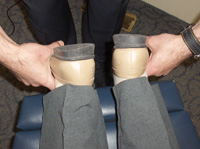 |
|
| Picture 1: Activator Analysis finds a short right leg in the extended position (Position 1). This is named the pelvic deficient (PD) leg.
|
|
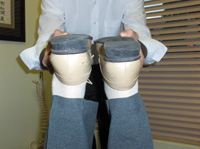 |
|
| Picture 2: The PD leg becomes longer in the flexed position (Position 2). This typically indicates pelvic subluxation involvement.
|
|
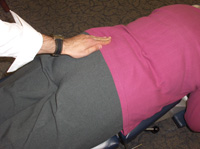 |
|
| Picture 3: AS Ilium pressure test. Apply a gentle inferior and medial pressure along the iliac crest, on the contra- lateral side of the PD leg. Perform the test in a plane parallel to the plane line of the sacroiliac joint. |
|
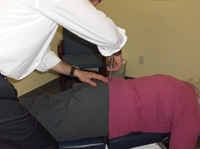 |
|
| Picture 4: AS Ilium Adjustment, Contact 1. Sacral base opposite side of PD leg. LOC: Anterior-Inferior.
|
|
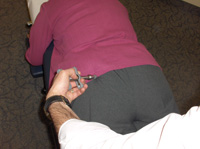 |
|
| Picture 5: AS Ilium Adjustment, Contact 2. Iliac Crest. LOC: Inferior-Medial.
|
|
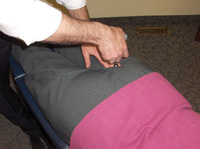 |
|
| Picture 6: AS Ilium Adjustment, Contact 3. Ischial Tuberosity. LOC: Anterior-Inferior.
|
The doctor is proficient in the Activator Methods Chiropractic Technique (AMCT), and Activator leg length analysis reveals a short right leg in the extended position (pelvic deficient-PD leg), and a lengthening of the right leg (PD leg) in the flexed position.
What do these findings indicate to the chiropractor who is proficient in the Activator Method? How does the Activator practitioner confirm his/her findings, and how is the Activator Adjusting Instrument properly used to correct the subluxation findings? In this edition of Technique Toolbox, I will answer these questions and discuss the AMCT’s approach to solving our case.
BUT FIRST, A LITTLE BACKGROUND
The use of instruments to set bones dates back as far as the Mayan bonesetters and Crow Indian healers, both using simple hand-held percussive devices. Chiropractic came to adopt this and the earliest known chiropractic instrument adjusting is credited to Dr. Thomas Storey, who utilized wooden chisels and mallets for adjusting. It goes without saying that the profession has evolved since then in its use of instruments.
In 1964, Drs. Warren Lee and Arlan Fuhr established the Activator Method, which eventually incorporated an instrument for adjustments. This technique had, at its basis, the Logan Basic technique, utilizing a thumb thrust, which caused repetitive strain to the doctor’s hands. Drs. Lee and Fuhr wanted to create an instrument that would reduce the physical stress on the doctor and also control the thrust to the patient. The Activator Adjusting Instrument was created in 1967 through modification of a dental impact hammer. The Activator is based on the principle that the greater the speed of the instrument, the less force that is needed to perform the adjustment.
Ever since its inception, the Activator Adjusting Instrument has been continuously refined to improve its adjusting capability and reduce user error with the instrument. But this method is not just a simple extension of instrument-driven bone treatment. Lee and Fuhr’s goal was to create a technique that could also offer guidance to a chiropractor on where, when, and when not, to adjust a patient. Activator analysis incorporates leg length observations, isolation testing and pressure testing to locate the subluxation.
RESEARCH
AMCT is truly a leader in the chiropractic research field, having published more than 100 research papers in peer-reviewed journals. Dr. Fuhr and his team have worked tirelessly for decades producing clinical trials on the effectiveness, reliability and safety of the technique. Currently the Activator Method is being studied by two independent research teams funded by NIH grants. One is studying the temporomandibular joint, and the other is researching the possibility of decreasing inflammation with an Activator adjustment. Furthermore, research has shown that the AMCT is the most widely used instrument technique in chiropractic, and that it is the second most commonly used technique in Canada.1
OUR CASE STUDY
In our case, AMCT leg length analysis of the PD leg lengthening in the flexed position is frequently associated with a pelvic subluxation. However, the knees and feet should be tested and adjusted prior to testing the pelvis, if subluxations in these extremities are present.
Step 1: Leg length findings (see Pictures 1 and 2)
- Patient: Prone
- Doctor: At foot of the table
- Observation: Short right leg (PD leg) in the extended position
- (Position 1). This leg appears longer when flexed to 90 degrees (Position 2).
Step 2: Test and adjust knees and feet as needed
- Let us assume for our discussion that analysis confirmed that no subluxations were present with these extremities, yet the PD leg is still present.
- Move on to pelvic analysis and correction.
Step 3: Proceed to pelvic pressure tests (see Picture 3)
In AMCT, joints are tested by the application of a gentle force into the direction of the adjustment. A positive pressure test indicates the presence of a neuro-articular dysfunction or involvement as observed by the leg length balancing, or becoming more even, in Position 1.
The doctor will first test if an Anterior-Superior (AS) Ilium subluxation is present, contra-lateral to the PD leg.
- Patient: Prone
- Doctor: Apply a gentle inferior and medial pressure along the
- iliac crest, on the contra-lateral side of the PD leg. Perform the test in a plane parallel to the plane line of the sacroiliac joint.
- Findings:
- When an AS Ilium subluxation is not present, the pressure test will not balance the legs.
- When an AS Ilium subluxation is present, the pressure test will balance the legs. If this is the case, the doctor will move on to Step 4.
Step 4: AS Ilium Adjustment using the Activator Instrument (see Pictures 4 to 6)
- Patient: Prone
- Doctor: At side of table
- Activator Setting: Set to ring 6 using Activator II or Setting 4 using Activator IV
- Contact 1: Activator on the sacral base, opposite side of the PD leg
- Contact 2: Crest of Ilium
- Contact 3: Ischial Tuberosity
- LOC 1: Anterior-Inferior
- LOC 2: Inferior-Medial
- LOC 3: Anterior-Inferior
Following the adjustments using the Activator Adjusting Instrument, the doctor will recheck the patient’s leg length findings, and move on to the next area of subluxation according to the protocol.
AMCT is widely supported by research, and provides the chiropractor with a safe and effective alternative procedure to manual adjusting. As usual, I have only scratched the surface of the AMCT. If you would like to learn more about Activator, please go to www.activator.com, or www.activatoronline.com.
Until next time . . . Adjust with Confidence!
Reference:
Gleberson B. Chiropractic Name Techniques. A review of the literature. JCCA. 2001. 45(2) 86-99
Dr. John Minardi is a 2001 graduate of Canadian Memorial Chiropractic College. A Thompson-certified practi-
tioner and instructor, he is the creator of the Thompson Technique Seminar Series and author of The Complete Thompson Textbook – Minardi Integrated Systems. In addition to his busy lecture schedule, Dr. Minardi operates a successful private practice in Oakville, Ontario. E-mail johnminardi@hotmail.com, or visit www.ThompsonChiropracticTechnique.com .
Print this page